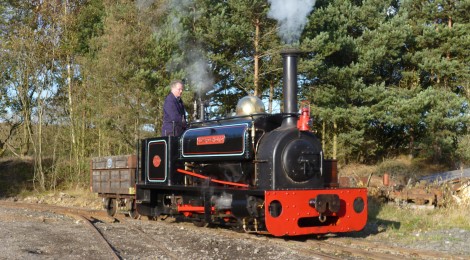
Narrow Gauge Developments (and meetings!) – November 2014…
On Saturday we made a start with a new team formed to tackle narrow gauge projects on a volunteer basis, partly formed from staff and also from other folks of a like mind. The first projects are the rebuild of a former ammunition wagon and one of the FR granite waggons. Once we get up to speed, further waggons will be tackled, both restoration and recreation/replication, to give us a suitable selection of vehicles to demonstrate to visitors on the narrow gauge railway. Attended by good weather, we began our work…
Below: The Hudson ‘Bomb’ wagon was the first item of rolling stock tackled, shortly followed by the first of the FR granite wagons – we will rebuilt the two in parallel. Here a meeting takes place to decide who has the largest hammer (and therefore becomes the most effective wagon restorer!). Meetings were an important function of the day and were held every few minutes to make sure we stayed on track!!!
Below: Paul and Chris get to work while Jim and Claire hold a meeting to discuss the use of the hammer in the foreground, meanwhile Edward Sholto carries out footplate riding duties in the background.
Below: The stripped down chassis – to see what we do with it, watch this space…
Below: The cleansing power of fire… The ironwork is recovered from a bonfire (before it distorts) for further reuse on projects here. This demonstrates a more informal meeting taking place!
Below: To keep us company (and warm!) we had Edward Sholto in steam, shunting and also offering footplate rides as well as posing for photographers with the 1889 Marshall ‘Mary Margaret’ which belongs to Michael Davison.
Below: Not to be left out, the engines also held a meeting…
Below: One thing we are always struggling for when operating is adequate watering facilities. To this end, we are using up bits and pieces of material stored around the Museum to create a fairly typical industrial railway water tower. The base has now been completed and planted, as seen below. Meanwhile, once the work required to manufacture the new Gallopers steps is completed, Chris will make a steel tank insert for a cast iron water tank that we have to hand, which will top this base and be plumbed in to provide for narrow gauge locomotive refreshment. A coaling area will also be created, and a lot of ash spread to blacken this area up further and hopefully improve the industrial ambiance at this location.


















Recent Comments